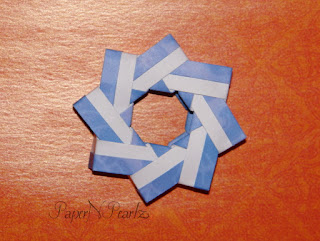Happy Valentine's Day!
Well, this year for Valentine's, I decided to fold a long-pending model that has been on my to-do list for the past 3-4 years. Every year I miss Valentine's Day and decide to fold the model the next year. Finally, this year, I actually remembered to give this model a go.
This is an origami wreath, designed by the amazing Francesco Guarnieri! I love folding wreaths - they are modular origami and I absolutely adore modular origami and they are quick to fold, given that they usually require 8 modules (as opposed to the usual 30-unit modulars that I fold). So this origami Garland of hearts (Ghirlanda di cuori) fit the bill very nicely.
I used double-sided, red-pink 60 gsm origami paper, which turned out perfect for this model. 7.5 cms (3 inches) squares resulted in a wreath that measured about 12.5 cms (~ 5 inches) in diameter.
Folding the individual modules started off easily enough. The last couple of steps, where the 3-D heart is folded, was a little tricky. Loved the way the heart locks into place! The join between the modules is easy and very stable - absolutely no glue required for this one! Overall, a lovely model to fold.
For this Valentine's Day, why don't you give this a go?
Model Details:
Model: Origami Garland of Hearts (Ghirlanda di Cuori)
Creator: Francesco Guarnieri
Difficulty Level: High Intermediate
Paper Ratio: Square
Paper Size: 3 inch square
Model Size: ~ 5 inches across
Modules: 8
Instructions: Origami poesie di carta























